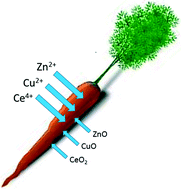Accumulation of zinc, copper, or cerium in carrot (Daucus carota) exposed to metal oxide nanoparticles and metal ions†
Abstract
The release of engineered nanoparticles (ENPs) into the environment has raised concerns about the potential risks to food safety and human health. There is a particular need to determine the extent of ENP uptake into plant foods. Belowground vegetables growing in direct contact with the growth substrate are likely to accumulate the highest concentration of ENPs. Carrot (Daucus carota) was grown in sand amended with ZnO, CuO, or CeO2 NPs or the same concentrations of Zn2+, Cu2+, or Ce4+. Treatment with ZnO or Zn2+ produced a concentration-dependent decrease in root and total biomass. Ionic Cu2+ and Ce4+ caused a greater reduction in shoot biomass as compared to the corresponding ENP treatments. Accumulation of Zn, Cu, or Ce in the taproot was restricted to the taproot periderm. Metal concentrations in the taproot periderm were higher for the ionic treatments than for the ENP treatments. Radial penetration of the metals into the taproot and subsequent translocation to shoots were also generally greater for plants receiving the ionic treatment than those receiving the ENP treatment. The distribution of the metals from the ENP treatments across the periderm, taproot, and shoots differed from that observed for the ionic treatments. Overall, the ENPs were no more toxic than the ionic treatments and showed reduced accumulation in the edible tissues of carrot. The results demonstrate that the understanding of ionic metal transport in plants may not accurately predict ENP transport and that an additional comparative study is needed for this and other crop plants.

- This article is part of the themed collections: Sustainable Nanotechnology Organization 2014 and Environmental Science: Nano 2016 Most Downloaded Articles

 Please wait while we load your content...
Please wait while we load your content...